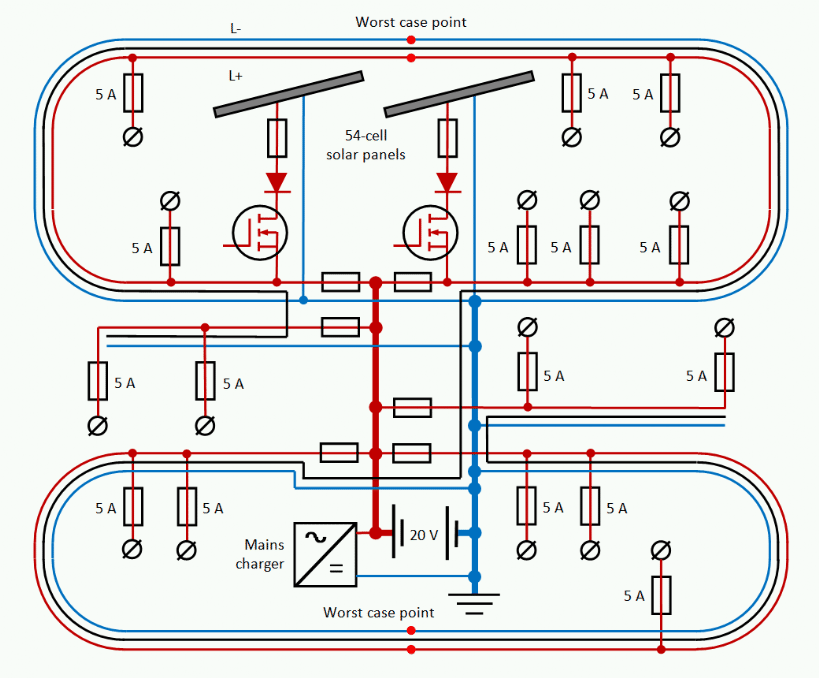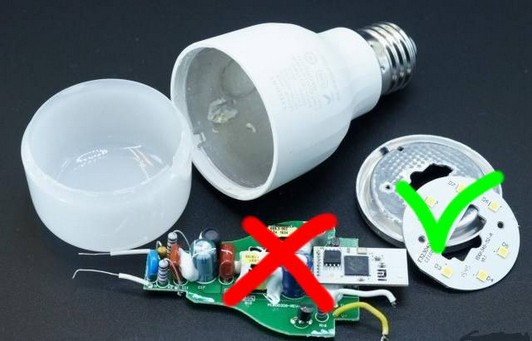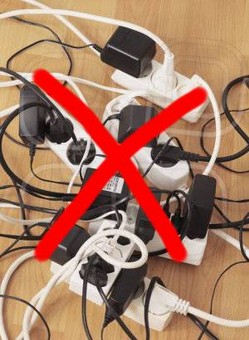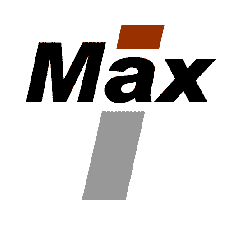The Green Smart House Solution

Traditional Light Dimming
For many years, lighting in buildings has been implemented with simple point-to-point connections between wall switches and lamp outlets in the ceiling. This is easy to overlook and install by any electriciant, which is very important, but it it has a lot of disadvantages:
- All the point-to-point connections make it impossible just to use flat cables and connect everything by means of piercing technique.
- A failure on the neutral conductor, which is often routed through several contacts and outlets, may cause the voltage to raise from 230 Vac to 400 Vac if another phase is heavily loaded, which may destroy a lot of equipment and even cause fire.
- It is very difficult to rebuild - especially in low energy houses with an unbroken vapor barrier between outer walls where it may be necessary to remove the ceiling.
- There is no or very limited ways to implement more advanced features like multi-way (landing) switching, all-off and smart-house features. It is for example not possible to record daily behaviour and thus simulate the presence of people in a plausible way when no one is home.
- Most dimmers can only control one lamp and therefore cannot replace a double switch.
- Because most LED-drivers and LED-bulbs have a capacitive input, the dimmer needs to be a trailing-edge type, which is much more expencive than a simple leading-edge TRIAC dimmer.
- There may be a minimum wattage, with can be difficult to fulfill with LED lamps and may require a resistor, which burns off energy all the time.
- The flicker-free dimming range is usually very limited - often to only 10 %, which the eye only regards as a 2.7 times reduction in light intensity.
- Induced currents may get LED lamps to glow all the time.
Distributed I/O
This is a more advanced version where groups of control modules in one or more control cabinets are linked together by means of a fieldbus so that some cabling can be spared. Each control cabinet contains one or more modules for example for:
- Power supply.
- Central controller.
- On/off, open/close or "american" 3- or 4-level switching.
- Direct lamp dimming by means of 230 Vac or 115 Vac leading edge or trailing edge outputs.
- Indirect lamp dimming by means of control signals to other devices like for example 0-10 V, 1-10 V or a fieldbus like Dupline, DALI or KNX.
- Boolean (digital) on/off or multistate sensors.
- Analog sensors and inputs for example for energy, temperature, water, humidity, fire, smoke, air quality, 4-20 mA etc.
There are however still a lot of serious disadvantages:
- It is a very expensive and physical big solution because it requires one or more cabinets and a lot of different and often expensive modules.
- It is not possible to communicate directly between devices without the use of a central controller for example directly from a switch to one or more lamps. This makes programming much more difficult and reduces the reliability and failure tolerance.
- It is impossible to add new features before a module for that functionality is available.
- Although some cabling is spared, there is still a point-to-point connection from each modules to the connected device(s).
- It is usually necessary to draw new cables if the system is expanded or rebuild.
- The limited number of modules in each cabinet may make it impossible to expand, or it may be necessary to mount a new cabinet, which may be difficult to find space for.
- The used fieldbus usually does not have enough power to drive actuators, lamps and sensors directly so it is usually necessary with a power supply - either through the modules like switching and direct dimming or to the devices themselves. This may make it necessary with further cabling and maybe a galvanic separation between fieldbus and power supply to prevent ground loops.
- The fieldbus is often proprietary so that it is impossible to use modules from different vendors. This may make it impossble to expand and/or repair the system.
The new Trend
To work aound the limitations of these methods, by far the majority of all smart-house systems today use wireless communication, battery driven contacts and sensors, battery or mains driven actuators and mains driven lamps. This is very easy and fast to install even in existing houses where it is very difficult or almost impossible to draw new cables, but it's like peeing in your pants to keep warm. After the initial advantage, it is just an endless row of serious disadvantages:
Wireless connunication
- Wireless communication may be disturbed by other communication in the same band and may be jammed so that for example alarm systems either don't work or create false alarms with perhaps a loud siren sound in the middle of the night, which a thief may utilize to force the owner to switch it off.
- Wireless communication may be hacked, and WiFi based systems may even open a back door into your computer network on the wrong side of the firewall so a very high degree of safety and credibility is necessary. All manufacturers of devices on the network must be trusted and must guarantee that their devices are safety updated even several years after the purchase! In practice, this is usually impossible!
- It is extremely difficult to log and decode the activity so it is virtually impossible to ensure that wireless systems do not send unwanted information about your behaviour or even pictures to hackers, Google, alarm companies and dubious websites.
- It is usually necessary with routers, gateways etc., and if something don't just work out of the box, you may be in serious trouble and often on your own.
- Safe wireless systems like Matter over Thread require a fairly expensive microprocessor with an advanced (128 bit) cryptographic engine and a lot of extremely complicated software layers on top of each other, and the devices must be certified and go through a very time-consuming and expensive conformance test. This makes the devices very expensive and difficult to make - especially for small companies, who wish to enter the smart-house market. From August 1st 2025, similar security requirements will apply to all wireless devices sold in Europe as they must comply with the RED DA radio directive where cyber security is built in so that they cannot harm other connected devices and applications and at the same time guarantee personal data privacy in connection with the communication. It is expected that there will also be requirements for patch management, where in the future companies must be able to proactively deliver software updates to patch security holes. This means that even low-cost devices from China must be allowed Internet access, increasing the risk of malware considerably.
- Systems like Matter, which standardize the interoperation on device and function level, are very much like standard Windows drivers - they can handle the most basic functions, but will never be able to keep up with new, advanced features.
- Complicated standards change very fast and may make older systems obsolete. There are numerous examples of smart-house systems, which cannot be expanded or rebuild after just a few years, and that newer products from the same manufacturer are not even backward compatible! If a smart house system cannot easily be serviced, safety updated, rebuild and expanded for a very long period af time and not just by the one, who has installed it, it can reduce the value of the house!
Battery driven devices
- Batteries require many resources to make and recycly. For example, it requires approximately 270 Wh to produce a single AA alkaline battery, but the stored energy is only approximately 3.9 Wh, which is 70 times less, so battery-driven devices are very far from being green if they are not rechargeable.
- Small batteries do not have enough power for example for solenoid driven devices like locking pawls and for intelligent and fail safe alarm sensors and especially not for sensors based on AI (Artificial Intelligence). In the future, AI will enable many unprecedented possibilities such as facial recognition, alarm sensors that can distinguish between humans and animals, fall detection of elderly people, etc., but the downside is a very high power consumption, which excludes systems based on battery-powered devices from keeping up with the technical development.
- There may not be power enough to supervise an alarm sensor more frequently than typical once every 10 minutes, which delays any tamper detection.
- The batteries must be replaced fairly frequently if a device is to be expected to work. In a typical Bluetooth or WiFi contact, the batteries only last for 2 - 5 years depending on the use and in door locks, it is typical only 1 year. If you choose a battery driven solution, you will be facing an endless battery replacement for years to come, which is certainly not very green and can even be very difficult for elderly people.
- The low battery voltage of typical 3 V is far too low to burn through corroded contacts, which requires a fritting voltage of approximately 100 V/µm, so the usual click contacts may work fine on new devices, but after a few years, you may experience that you have to push the buttons hard many times to make them work or they don't work at all and these problems only get worse.
- Battery leakage and moisture very often cause bad connections and corrosion and together with the short service life it is a very big problem for actuators like radiator thermostats, locking systems and access control. The battery voltage may be high enough for stand-by, but not for operation, so a bad battery or a corroded connection may not be detected before it is too late and you may stand outside your house in rain or snow with no way to enter unless you have a powerbank to power the lock.
Mains driven devices
- The devices need to be powered up permanetly and must therefore not be forgotten in off-state. This is especially a problem if a device is driven from an outlet in the ceiling or on a wall.
- It is not possible to drive the devices directly from a house hold battery. This makes it very expensive to utilize solar panels to save energy.
- The necessary AC-DC converter increases the price and size of the devices considerably and may even be a clumsy "brick" on the cable.
- It may cause a risk of fire and/or shock due to the high mains voltage and often very doubtful quality and cooling.
- It generates electrical noise.
- It may turn off for a short time in case of transients or voltage drops.
- It require big resources to make and is difficult to recycle due the the use of toxic epoxy boards and big components with the result that the device often just end up as waste in the incinerator or even on the landfill.
- It limits the service life of the device considerably - typical to less than half, which makes the waste problem even bigger.
- It often results in a chaos of socket outlets, chargers and cable spaghetti on the floor with very low "Woman Acceptance Factor" - WAF.


A different Sustainable Solution
In 2023, 61.3 million tons of electronics - more than the weight of the Great Wall of China - ended up as wast globally and UN estimates that this will grow to 74 million tons in 2030 and 120 million tons in 2050. The best solution to this is simply to avoid most of the electronics, and this is what Max-i makes possible!
The high power capability and use of standard installation cables in a "multi-loop plus two tails" structure as shown on the drawing on the top of this page makes it extremely suited as a supplementary 20-Vdc power supply with control possibilities in the houses of the future. It can replace all the point-to-point connections, most mains voltage converters and chargers and be used to drive and control low to medium-power equipment like for example:
- Advanced LED lighting.
- Everywhere where a safe voltage level is important like children's rooms, garden, bassin and pool lighting and fountain and aquarium pumps.
- All kinds of chargers for mobile phones, tablets, toys, cameras etc.
- Window openers and sun shading.
- Computers except for high power gaming PC's.
- Computer peripherals like screens, modems, routers and gateways.
- Low power infotainment systems including TV's up to approximately 50".
- Weather stations and sensors for temperature, CO2 etc.
- Energy management systems.
- Door bells.
- Coupled smoke alarms.
- Alarm systems for example for theft, gas and water.
- Locking systems and access control.
- Low energy refrigerators and freezers. A typical low-power refrigerator plus a freezer use only approximately 35 W in average, and a household battery can easily supply the inrush current of the compressor.
In a typical house, such devices use approximately 55 % of the electricity exclusive electric heating, so in case of solar panels, a huge energy saving is possible at a fraction of the cost of a traditional AC system, which is also designed for driving all the high-power devices like stoves, ovens and other kitchen appliances, washers and dryers, vakuum cleaners etc. With Max-i, high power devices are still driven by the mains voltage. Calculations done by the Danish engineering company Rambøll shows that such a low-voltage DC-network can save the Danish households in the order of 1 billion Danish kroner per year corresponding to approximately 134,000,000 Euro or $144,000,000.
There are two primary reasons to chose 20 V instead of the much more common 24 V or 28 V.
- It is the highest voltage, which cannot cause a dangerous arc at high current levels as described on the "Home" page.
- It has become the de facto standard for the maximum level for many chargers for mobile phones, tablets and laptop computers as listed below:
- USB Power Delivery (USB-PD) up to version 3.0 (20 V, 5 A = 100 W). Version 3.1 however goes up to 48 V, 5 A = 240 W.
- Quick Charge from Qualcomm (20 V, 5 A = 100 W).
- Motorola TurboPower (20 V, 6.25 A = 125 W).
- SUPERVOOC Endurance Edition (20 V, 7.5 A = 150 W).
- Infinix (20 V, 8 A = 160 W).
- Xiaomi HyperCharge (20 V, 10 A = 200 W).
- Realme (20 V, 12 A = 240 W).
- Lenovo Slim-tip (20 V,
- 1.75 A = 36 W,
- 2.25 A = 45 W,
- 3.25 A = 65 W,
- 4.50 A = 90 W,
- 6.75 A = 135 W,
- 8.50 A = 170 W,
- 11.5 A = 230 W).
The 100 W of both USB-PD 3.0 and Quick Charge is due to the safety standard IEC 60950-1, which specifies a maximum power of 100 W and a maximum current of 8 A. In this way, "the maximum apparent power and fault current available on the outlet under any load conditions including a short-circuit are limited to magnitudes not likely to cause ignition under fault conditions in connected equipment mounted on, and constructed from, suitably rated materials." Higher power and current levels should be used with great care - especially if a USB-C connector is used as a standard USB-C connector and cable can only handle 5 A continuously!
In sunny areas, it may be possible to drive the devices totally off-grid even in the winter, and the excess power in the summer may then for example be used to drive a ventilation heat pump and additional 24-V heating elements so that the house gets ventilated and additional heating is not needed most of the year, which can save a lot of energy. The outlet of cold, dry air from the heat pump can even be used for a (supplementary) compressor-less refrigerator to squeeze the last efficiency out of the system and make the household even less vulnerable in crisis situations. As the global temperature is rising (AGW) this is especially important in areas, which are often hit by hurricanes, but the war in Ukraine has also shown that the first thing an enemy will do is to destroy the power infrastructure. Without electricity, the citizens has no light, no communication, no heating, no water and after just one week, any food in freezers and refrigerators may be destroyed so they may even starve. The ability to run off-grid (islanding) with the most important parts will therefore become more and more important in the future and with Max-i, it is possible to realize this at a very affordable price and without any shock hazard in case of floods or damages, which must be repaired.
Even though many traditional photovoltaic systems have batteries, they generate AC for the grid and must therefore have "Grid - Anti-islanding" to prevent that a disconnected grid is powered up and therefore becomes dangerous to the utility workers, so the majority of these cannot run off-grid, and the few ones, which can, are very expensive. With traditional systems, you may find yourself without electricity even though you have the roof full of solar panels.

Max-i is also the ideal replacement for the traditional 12-V systems in mountain huts, hunting lodges and holiday cottages without any grid connection. The higher voltage is better suited for LED lighting and can be used to charge and drive mobile phones and laptop PC's directly, and the inherent possibility for light dimming makes it possible for a household battery to last much longer in periods without sun and wind such as high pressure weather in winter. Because of the logarithmic characteristic of the eye, the power consumption is reduced to only 18 % if the light is just dimmed to what the eye regards as half. Besides, the multi-drop line is easier to install in a nice way than point-to-point connections between buttons and lamps.
If there is not enough solar power to supply the system in the winter, a grid-powered charger may be necessary as a supplement, but it can be quite small and thus inexpensive as it should only be able to deliver the average power. Besides, it can charge the battery when the grid is low-loaded and/or the share of renewable energy is high and thus both save money and CO2 emissions. Of cause it is also possible to add a 230 Vac or 115 Vac inverter directly to the battery and in this way sell excess electricity to the power grid and/or install high voltage outlets, which may be used to drive equipment, which cannot be driven from 20 Vdc. The inverter must however be switched off in periods where it is not needed (loaded) as it would otherwise drain the battery.
Max-i can be installed and serviced by any electrician and like most other hardware standards like CAN, it does not get obsolete overnight. For smart house applications where there is no problems with mutual coupling to other cables and high current levels are needed, Max-i uses a 5-conductor industrial flat cable with two conductors (1 and 5) for positive voltage (L+), two (3 and 4) for negative voltage (L-) and one (2) for communication (COM), and it uses piercing technique to get contact and make outlets without cutting the cable. If more power is needed than possible with a pure 20-V system, conductor 4 and 5 may instead be used for mains voltage (mains-plus-dimming) as shown below:

If each device has a power supply, which can generate the 20 V (L+) from the mains voltage, it is even possible with only a 4-wire cable, but in that case, it is not possible to drive 20-V low-power devices like sensors and actuators from the same cable.
Security, Privacy and Safety
Security is of the utmost importance to many people, and Max-i can fulfill even the strictest requirements:
- It has power enough for even the most advanced and fail safe sensors and for driving locking pawls by means of solenoids.
- The supply voltage of 20 Vdc is high enough to create a reliable function of sensor contacts and push buttons.
- It is fast and powerful enough to destroy the night vision of a thief by means of powerful light flashes.
- It is not accessible from outside (unless a gateway/border-router is added), so it is not necessary with advanced encryption standards etc., which makes the necessary electronics much simpler, cheaper and smaller and increases the efficiency a lot.
- It cannot be jammed unless you get physical access to the cable or an outlet with enabled communication, which should only be possible from alarm monitored areas.
- For by far the majority of applications, it is entirely hardware based and therefore cannot be reprogrammed to anything else than its dedicated purpose so there are no "mousejack" or other malware problems.
- It is very easy to log and decode all communication to ensure that nothing or nobody transmit unwanted information behind your back. The Max-i controller even has a fairly advanced acceptance filter, which can block telegrams, which would otherwise overload the log-system.
- There is virtually no limitations on how many devices you can connect without any noticeable degrade of performance.
- In daily use, you don't need an internet connection, which keeps even the best hacker out. Even when you need it, the connection only goes through one device, which is much easier to keep safety updated.
- It can easily be installed by the user just by connecting the sensors to a free outlet, and polling or heartbeat can then ensure that an alarm is triggered, if a sensor is disconnected.
- There is virtually no electromagnetic fields - not even from 50 Hz or 60 Hz solar power inverters.
Simplicy and Efficiency by Design and in Use
Unlike most other smart-house (and fieldbus) systems, Max-i is extremely simple end efficient and very easy to use:
- The entire Max-i specification fils only approximately 250 pages, but over half is background material and annexes. As a comparison, most other fieldbus systems and wireless systems have specifications of well over thousand pages that you need to read and understand.
- It is not necessary with big software stacks, expensive and time consuming conformance tests and perhaps consulting assistance. The entire protocol is handled in hardware, so you cannot do anything wrong, and by far the majority of applications can just use one of the standard objects. The only things you have to do to make a very advanced and reliable smart-house product is therefore to buy a chip (when it becomes ready), copy an application note and you are ready to sell to a price, which is lower than a wireless solution and much lower than distributed I/O.
- The publisher-subscriber method, which addresses the various process values instead of the devices, makes it unnecessary to specify a lot of device data models, which anyway almost always will be more or less outdated. Even the most complex device now and in the future like mass flow gauges with several hundred setup parameters and features, which will never be standardised, just publish and consume a number of values, so it is only necessary to specify a few standard data types.
- With the long 31-bit data identifier, only 9 bytes are needed to set for example the hue and smoothing time of a tunable white lamp and this includes a 20-bit CRC check to detect errors and a 7-bit Hamming code on the identifier to protect against masquerading. As a comparison, the following table shows what Matter over Thread uses for the same job:
Matter over Thread | Bytes | Bytes |
802.15.4 PHY Header | 6 | |
Preamble Sequence | 4 | |
SOF | 1 | |
Frame Length | 1 | |
MAC Header | 7 - 37 | |
Frame Control | 2 | |
Sequence Number | 1 | |
| Address Information | 4 - 20 | |
| Auxiliary Security Header | 0 - 14 | |
MAC Payload | 28 or 33 | |
| Any Mesh Header for Multihop | 0 or 5 | |
6LoWPAN Header | 20 | |
ICMPv6 Header | 8 | |
Data Payload Layers | Maximum 73 or 78 | |
Message Framing and Routing | ? | |
Security Encryption and Signing | ? | |
Action Framing | ? | |
Interaction Model Interaction 1 with another Data Model Transaction 1 Action 1 Action 2 Transaction 2 Action 1 Action 2 Action 3 Interaction 2 with another Data Model Transaction 1 Action 1 Action 2 Action 3 Transaction 2 Action 1 Action 2 | ? | |
Device Data Model Device Node n Endpoint 0 Cluster: Descriptor server DeviceTypeList server Cluster: BasicInformation server VendorName attribute (16 bit) ProductName attribute (16 bit) Startup event Cluster: GeneralCommissioning Endpoint n - Dimmable Light Cluster: OnOff server OnOff attribute OnTime attribute Toggle command Cluster: LevelControl server CurrentLevel attribute MoveToLevel command MoveWithOnOff command | ? | |
Application layer | ? | |
MAC MIC | 2 | |
| MAC MIC | 2 | |
Frame Check | 2 | |
FCS | 2 | |
Not only is the data model and the underlying layers extremely complex, but before two devices are able to talk to each other, it is even necessary to build an encrypted communication channel (interaction relationship) between them, so unlike Max-i, devices including debuggers cannot just be added and removed "on the fly" at any time.
The fundamental difference between device addressing and device data models, like the one used by Matter, and the publisher-subscriber model with just a few standard data types, as used by Max-i, can be illustrated with the difference between Japanese and Chinese logographic kanji characters and Latin letters. There are approximately 3000 Jinmeiyou kanji in daily use, which not only are quite hopeless to learn, but cannot keep up with the technical development. On the other hand, 26 english, latin letters are all, which is needed to describe everything now and in the future! Therefore, the Japanese industry standard JIS X 0208:1997 has also added 6879 kanji characters more, which works very much like latin letters (IBM code page 952) and are suitable for writing text, place names, personal names etc.
Even though Max-i is very simple, it is much more powerful than most other fieldbus systems and especially wireless systems. On a typical 180-m line, which is adequate for most smart-house systems, it only takes an average of 454 μs to send a message to one or more dichromatic lamp. This is at least 5.5 times faster than DALI, 44 - 88 times faster than KNX, up to over hundred times faster than Matter over Thread and over thousand times faster than Bluetooth LE, and Max-i is even faster if the ability to transmit data to more lamps in the same telegram is utilized. In that case, it can be used for professional stage light with a performance far, far above what is possible with Matter, Philips Hue, DALI, KNX or any other smart-house system today.
Max-i may be operated any way you want. Even without a central controller, you may for example control lamps, window openers etc. by means of traditional wall mounted buttons, which is usually the most convenient. In the long run, almost no one bothers to find the right app on a mobile phone every time they just want to turn a lamp on or off. The only difference you will experience with Max-i compared to a traditional system is perhaps a more beautiful touch control with light indication and that you simultaneously get a light dimmer in all lamps with a lot of features like night light and programmable start level, automatic daylight control, all-off (and all-on), synchronized multi-way landing switching and possibility for emergency light with programmable color (need to be reddish in case of smoke). If you connect the bus to a WiFi or Bluetooth interface, you may do the same from mobile phones and tablet and this also makes it possible to set different scenes and control the color hue in case of multi-color lamps. Max-i may of course also be connected to controllers and computers, which can enable more advanced functions like energy management and making the home looks inhabited when you are not at home. It is even possible for an advanced TV to control the light in real time from the image lighting with the same speed and performance as professional stage light.
"Everything should be made as simple as possible, but not simpler."
Albert Einstein
"Perfection is achieved, not when there is nothing more to add, but when there is nothing left to take away."
Antoine de Saint-Exupéry.
.This page is created with WebSite X5 and updated January 17th 2025
